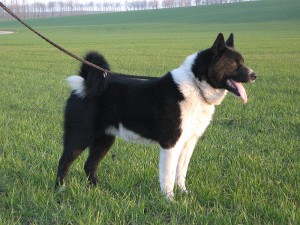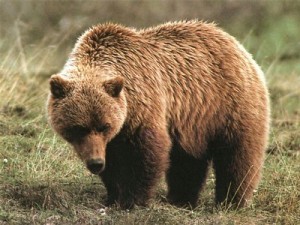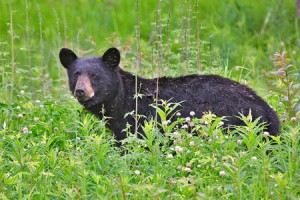Many people get nervous when they realize they’ll be paddling and camping in bear country. In fact, about 75% of Alberta is Bear country, but it’s the part of the province with the least population. So many people are unfamiliar with bears and what to do to avoid a bear encounter — and what to do if you have one.
The most important thing to do is KEEP YOUR WITS ABOUT YOU.
You should always keep your wits about you when you’re in the wilderness, but this comes into play especially when you see a bear. Stay calm, and observe the situation. Look at the bear, and see if it looks agitated, surprised, or angry. Look around for any cubs. See if the bear has an escape route; if it doesn’t appear to have one, try to give it one. Talk quietly so it knows you aren’t an animal. See if you can identify if it’s a Grizzly or Black Bear; refer to this BearSmart booklet for lots of great information about bear identification, bear behaviour, and what to do if you encounter a bear. A few highlights from that booklet include:
Everyone wishing to rent a canoe or kayak — or do any other type of outdoor recreation — in Northwestern Alberta should read the booklet before their trip.
You cannot tell the difference between the bears by colour; both Black bears and Grizzlies range from dark to blond colours.
The first thing to do is prevent encounters in the first place. You can do this by remembering that bears have a very keen sense of smell. Always think about what smells at your campsite, on your body, or in your tent. Keep your tent a smell-free zone — cook, wash dishes, store smelly clothes and all garbage about 100 m away from your tent. Do not sleep in the clothes you cooked or ate in. Put them in an airtight container or bag, or hang them in a tree (or between trees).
If you are walking on the shore looking for a spot to camp, go to the bathroom, or hang your food in a tree, be sure to make a little noise, so any bears in the bush nearby hear you and have the chance to get out of your way.
If you take these steps, you greatly reduce your chance of an encounter. Bears are not interested in eating you; they prefer other foods, such as plants, roots, insects, small mammals and animal carcasses. If you see wild strawberries, raspberries, or blueberries, devil’s club or wild sarsparilla, be extra-alert as these are some favourite foods.

Improperly managed garbage, compost, dirty barbeques, pet food, fruit trees and berry bushes can attract bears. This leads to “problem bears” — but in reality, human behaviour is the problem. In researching this article, I came across a new strategy for “problem bears.” Rather than killing or relocating the bears, there’s a program that uses Karelian Bear Dogs to scare the bears and “teach” them not to come back. Bears are smart and this program is very successful.
For more about bear behaviour, surf the Bear Smart Society’s pages, in particular, this interesting page.

